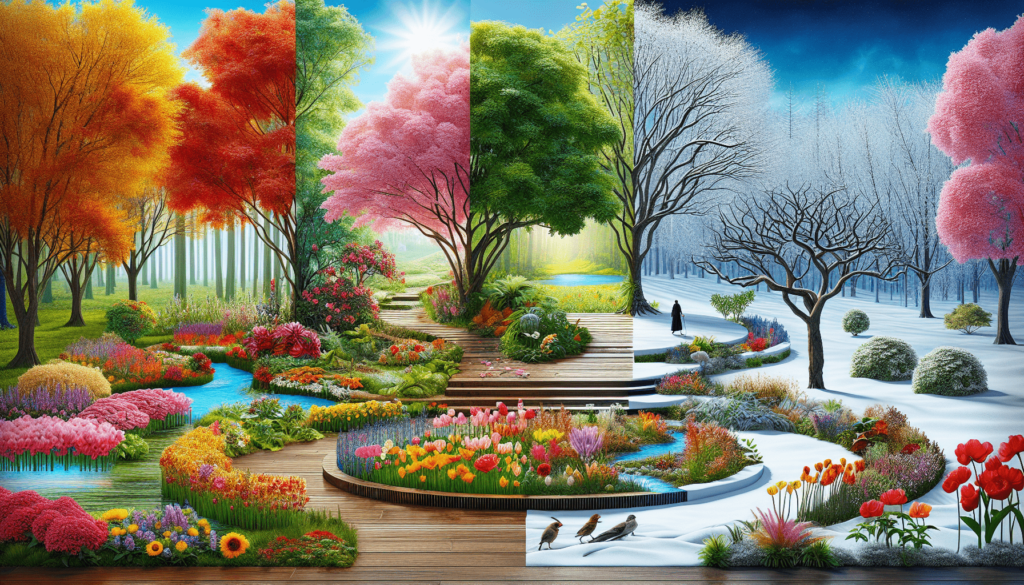Have you ever wondered how to create a garden that blooms beautifully in every season? Look no further! In this article, you will learn the secrets to designing a garden that changes with the seasons to keep your outdoor space vibrant and colorful year-round.
Planning Your Seasonal Garden
When it comes to designing a garden that changes with the seasons, the first step is planning. Consider the climate in your region, the types of plants that thrive in each season, and the overall aesthetic you want to achieve. By planning ahead, you can create a garden that looks stunning no matter the time of year.
Researching Plant Varieties
Researching plant varieties is crucial to designing a garden that changes with the seasons. Look for plants that bloom in the spring, provide shade in the summer, turn vibrant colors in the fall, and stay evergreen in the winter. By choosing a diverse selection of plants, you can ensure your garden remains visually appealing throughout the year.
Creating a Year-Round Color Scheme
A key aspect of designing a garden that changes with the seasons is creating a year-round color scheme. Choose a variety of flowers, shrubs, and trees in different colors that bloom at different times of the year. By incorporating a range of hues, you can enjoy a visually stunning garden no matter the season.
Seasonal Color Palettes
To create a cohesive color scheme, consider using seasonal color palettes. For example, plant pastel flowers in the spring, vibrant blooms in the summer, earthy tones in the fall, and cool hues in the winter. By following seasonal color trends, you can ensure your garden looks fresh and stylish year-round.

Utilizing Different Types of Plants
Another vital aspect of designing a garden that changes with the seasons is utilizing different types of plants. Mix annuals, perennials, bulbs, and shrubs to create a diverse landscape that blooms throughout the year. By incorporating a variety of plant types, you can enjoy a garden that evolves with each season.
Understanding Plant Lifecycles
Each type of plant has its own lifecycle, from spring bloomers to fall foliage. By understanding the lifecycles of different plants, you can create a garden that showcases a variety of colors and textures throughout the year. Be sure to research the growth habits of each plant to ensure a well-balanced garden.
Incorporating Seasonal Focal Points
To enhance the beauty of your seasonal garden, consider incorporating seasonal focal points. Plant a colorful tree that changes with the seasons, install a water feature that reflects the sunlight in the summer, or create a cozy seating area surrounded by fall foliage. By adding focal points, you can create visual interest in your garden year-round.
Choosing Seasonal Decor
In addition to plants, seasonal decor can add flair to your garden throughout the year. Consider adding colorful planters, festive garden flags, or whimsical garden statues that reflect the changing seasons. By updating your decor regularly, you can keep your garden looking fresh and inviting.

Maintaining Your Seasonal Garden
Once you have designed a garden that changes with the seasons, it is essential to maintain it properly. Regular pruning, watering, and fertilizing are all key to keeping your garden looking its best year-round. By staying on top of maintenance tasks, you can ensure that your seasonal garden remains healthy and vibrant.
Seasonal Garden Maintenance Checklist
To help you keep track of maintenance tasks, here is a seasonal garden maintenance checklist:
- Spring: Prune flowering shrubs, plant annuals, and fertilize the soil.
- Summer: Water regularly, deadhead flowers, and mulch around plants.
- Fall: Clean up fallen leaves, plant bulbs for spring, and protect sensitive plants from frost.
- Winter: Prune dormant plants, check for frost damage, and plan for next year’s garden.
In conclusion, designing a garden that changes with the seasons is a rewarding and enjoyable process. By planning ahead, selecting a variety of plants, creating a color scheme, incorporating focal points, and maintaining your garden, you can create a vibrant outdoor space that thrives year-round. So roll up your sleeves, grab your gardening tools, and get ready to design a garden that will impress in every season!

